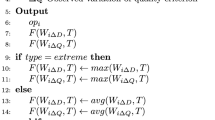Abstract
Portfolio optimization is an important aspect of decision-support in investment management. Realistic portfolio optimization, in contrast to simplistic mean-variance optimization, is a challenging problem, because it requires to determine a set of optimal solutions with respect to multiple objectives, where the objective functions are often multimodal and non-smooth. Moreover, the objectives are subject to various constraints of which many are typically non-linear and discontinuous. Conventional optimization methods, such as quadratic programming, cannot cope with these realistic problem properties. A valuable alternative are stochastic search heuristics, such as simulated annealing or evolutionary algorithms. We propose a new multiobjective evolutionary algorithm for portfolio optimization, which we call DEMPO—Differential Evolution for Multiobjective Portfolio Optimization. In our experimentation, we compare DEMPO with quadratic programming and another well-known evolutionary algorithm for multiobjective optimization called NSGA-II. The main advantage of DEMPO is its ability to tackle a portfolio optimization task without simplifications, while obtaining very satisfying results in reasonable runtime.
Similar content being viewed by others
References
Abbass HA, Sarker R (2002) Pareto differential evolution algorithm. Int J Artif Intell Tool 11(4): 551–552
Abbass HA, Sarker R, Newton C (2002) Pde: A pareto-frontier differential evolution approach for multi-objective optimization problems. In: Proceedings congress on evolutionary computation (CEC’2001), pp 971–978
Artzner P, Delbaen F, Eber JM, Heath D (1997) Thinking coherently. Risk Mag 10: 68–71
Artzner P, Delbaen F, Eber JM, Heath D (2005) Multiobjective differential evolution (mode) for optimization of adiabatic styrene reactor. Chem Eng Sci 60(17): 4822–4837
Chang TJ, Meade N, Beasley JE, Sharaiha YM (2000) Heuristics for cardinality constrained portfolio optimization. Comput Oper Res 27: 1271–1302
Chankong V, Haimes Y (1983) Multiobjective decision making theory and methodology. North-Holland, New York
Coello-Coello CA (1999) A comprehensive survey of evolutionary-based multiobjective optimization techniques. Knowl Inform Syst Int J 1(3): 269–308
Coello-Coello CA, David AVV, Gary BL (2002) Evolutionary algorithms for solving multi-objective problems. Kluwer Academic/Plenum, New York
Cont R (2001) Empirical properties of asset returns: stylised facts and statistical issues. Quant Financ 1: 223–236
Deb K (2001) Multi-objective optimization using evolutionary algorithms. Kluwer Academic/Plenum, New York
Deb K, Pratap A, Agarwal S, Meyarivan T (2002) A fast and elitist multiobjective genetic algorithm. IEEE Trans Evol Comput 6(2): 182–197
Fonseca CM, Fleming PJ (1996) On the performance assessment and comparison of stochastic multiobjective optimizers. In: Voigt H-M, Ebeling W, Rechenberg I, Schwefel HP (eds) Parallel problem solving from nature IV. Springer, Berlin, pp 584–593
Gaivoronski AA, Pflug G (2005) Value at risk in portfolio optimization: properties and computational approach. J Risk 7(2): 1–31
Gilli M, Kellezi E, Hysi H (2006) A data-driven optimization heuristic for downside risk minimization. J Risk 8: 1–18
Haimes Y, Lasdon L, Wismer D (1971) On a bicriterion formulation of the problems of integrated system identification and system optimization. IEEE Trans Syst Man Cybern 1: 296–297
Knowles J, Corne D (2000) Approximating the nondominated front using the pareto archived evolution strategy. Evol Comput 8(2): 149–172
Krink T, Paterlini S, Resti A (2007) Using differential evolution to improve the accuracy of bank rating systems. Comput Stat Data Anal 50(5): 1220–1247
Krink T, Paterlini S, Resti A (2008) The optimal structure of pd buckets. J Banking Financ 32(10): 2275–2286
Krink T, Mittnik S, Paterlini S (2009) Differential evolution and combinatorial search for constrained index tracking. Ann Oper Res. doi:10.1007/s10479-009-0552-1
Lampinen J (2009) A bibliography of differential evolution algorithm. http://www2lutfi/~jlampine/debibliohtm
Maringer D, Oyewumi O (2007) Index tracking with constrained portfolios. Intell Syst Financ Account Manage 15: 57–71
Markowitz HM (1952) Portfolio selection. J Financ 7: 77–91
Meyer RR (1975) Integer and mixed-integer programming models: general properties. J Optim Theory Appl 16: 191–206
Michalewicz Z, Fogel DB (2004) How to solve it. Springer, Berlin
Paterlini S, Krink T (2006) Differential evolution and particle swarm optimisation in partitional clustering. Comput Stat Data Anal 50(5): 1220–1247
Price K, Storn R, Lampinen J (2004) Differential evolution—a practical approach to global optimization. Springer, Berlin
Quintero LVS, Coello-Coello CA (2005) An algorithm based on differential evolution for multi-objective problems. Int J Comput Intell Res 1(2): 151–169
Rockafeller RT, Uryasev S (2002) Conditional Value-at-Risk for general loss distributions. J Bank Financ 25(7): 1443–1471
Sarker R, Coello-Coello CA (2002) Assessment methodologies for multiobjective evolutionary algorithms. In: Sarker R, Mohammadian M, Yao X (eds) Evolutionary optimization. Kluwer Academic Publisher, Boston, pp 177–195
Srinivas N, Deb K (1994) Multiobjective optimization using nondominated sorting in genetic algorithms. Evol Comput 2(3): 221–248
Storn R, Price K (1997) Differential evolution: a simple and efficient adaptive scheme for global optimization over continuous spaces. J Global Optim 11: 341–359
Streichert F, Ulmer H, Zell A (2003) Evolutionary algorithms and the cardinality constrained portfolio optimization problem. In: Selected papers of the international conference on operations research, Springer, Heidelberg, pp 253–260
Vedarajan G, Chan LC, Goldberg DE (1997) Investment portfolio optimization using genetic algorithm. In: Koza J (eds) Late breaking papers at the genetic programming 1997 conference. Stanford University California, Stanford University Bookstore, pp 255–263
Author information
Authors and Affiliations
Corresponding author
Rights and permissions
About this article
Cite this article
Krink, T., Paterlini, S. Multiobjective optimization using differential evolution for real-world portfolio optimization. Comput Manag Sci 8, 157–179 (2011). https://doi.org/10.1007/s10287-009-0107-6
Received:
Accepted:
Published:
Issue Date:
DOI: https://doi.org/10.1007/s10287-009-0107-6




